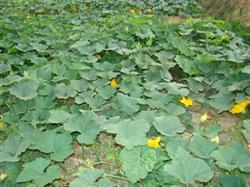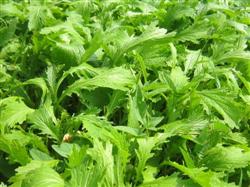What are the ways to grow mustard?

What are the ways to grow mustard? Mustard has the following planting methods: First, soil selection and soil preparation cultivation root mustard land should generally be melon, beans and solanaceous crops, the most should not be with cruciferous crops or mustard planted in the same year of the land continuous cropping. It can also be rotated with grain and rice. High yield can be obtained by planting root mustard in loam or clay soil with deep soil layer and rich organic matter. After harvesting, 225 ~ 30,000 kg of farm manure or compost is generally applied, and 300~375kg of calcium superphosphate, 120~150kg of potassium sulfate or 750kg of plant ash are added as base fertilizer. The amount of base fertilizer applied per hectare may vary depending on the fertility of the soil. Tillage and mix well with soil. Soil tillage depth should reach 25~30cm, after leveling the land, make 1.2 m high furrow, in mountainous and well-drained land can be used for low furrow cultivation. Second, sowing and seedling root mustard can be transplanted seedlings, can also be direct seeding. The root mustard of direct seeding has few abnormal roots, regular shape, high yield and good processing quality. In order to manage conveniently and make full use of land, many places adopt seedling transplanting to plant root mustard. 1, direct seeding (1) sowing time: root mustard sowing time is more strict, early sowing is easy to favor immature bolting, late sowing due to insufficient early nutritional growth, greatly affecting yield and quality, so it must be timely sowing. However, the sowing time of each place should be determined according to the local climate. In the south subtropical region, sowing should be carried out from late August to late September. In mountainous areas and places with poor water conditions, early sowing can be appropriate, and late sowing can be appropriate in fields with convenient irrigation and high soil moisture. (2) Sowing method: direct seeding of root mustard is usually carried out by opening holes and sowing seeds. The depth of opening holes is generally 2~3cm. Fine soil or fine residue fertilizer with plant ash is covered after sowing. If the field is wet when sowing, do not irrigate; if the soil is dry, irrigate it thoroughly and cover it again after sowing. When sowing, sow 5~6 seeds in each hole. When sowing, seeds should be scattered in the hole instead of sown in a pile. The sowing quantity per hectare is about 1.5~1.8kg. (3) Sowing density The fleshy root of root mustard is the raw material for processing pickled vegetables. If the sowing is too dense, the fleshy roots are too small to meet the processing standards; if the sowing is too sparse, the fleshy roots meet the processing standards, but they do not reach the ideal yield. Therefore, the sowing density of mustard should be determined according to the plant type size and plant development of each variety. Generally, the plant spacing of the varieties with small plant type and low expansion degree is 40×50cm, and the plant spacing of the varieties with large plant type and expansion degree is 50×55cm, and the plant spacing is about 37,500 plants per hectare. At the same time, according to the soil fertility and light conditions in various places, appropriate sparse or dense planting. Poor soil fertility and less light areas should be sparsely planted, good soil fertility and good light areas can be appropriately dense planting. 2, seedling transplanting root mustard in many areas is cultivated by seedling transplanting method, can also be plucked in the middle of the direct seeding field seedlings planted in other fields, seedling method and other mustard the same. But the sowing time of seedling is about 10 days earlier than that of direct seeding. In southwest and south subtropical areas, the sowing time of seedling is generally from late August to mid-September after the beginning of autumn, and the seedling stage is about 40 days. During seedling raising, attention should be paid to proper sparse sowing and thinning, so that the spacing between each seedling is about 7cm, and each seedling has a certain nutritional area, so that it can be cultivated into strong seedlings for planting. The planting period is from late September to mid-October. When planting, open holes according to the plant spacing of the variety, plant a strong seedling in each hole, require the straight root to be vertical to the center of the hole, fill with fine soil, irrigate the fixed root water thoroughly after planting, and water 1~2 times until all seedlings survive if there is no soaking rain before planting. 3, field management (1) thinning and supplementary seedlings root with mustard after sowing generally 3~5 days can emerge neatly, emergence of about 20 days, visible two leaves and one heart, to carry out thinning seedlings, direct seeding of each hole to leave 3 dwarf seedlings strong and maintain a certain distance between each other, and then grow 10~15 days, it is necessary to carry out fixed seedlings, each hole only 1 intact strong seedling. When determining seedlings, we should pay attention to the characteristics of the variety, remove impurities, remove inferior false leaves, and make use of the strong seedlings plucked out to supplement the missing holes. The seedlings that fill the holes should be filled with soil, and the roots should not be damaged to ensure that the seedlings survive once. Seedling planting in the seedbed about 20 days to carry out thinning seedlings 1 to 2 times, pull out the seedlings in the over-dense place, keep the seedlings in the seedbed uniform and healthy. When planting, the seedbed should be watered thoroughly first, and then pried the seedling with soil and planted in the field according to a certain plant spacing. 2, topdressing, irrigation, intertill weeding direct seeding when the seedlings see two leaves, in the thinning of seedlings at the same time after intertill weeding to topdressing the first fertilizer, this topdressing is mainly to raise seedlings, should be applied lightly, per hectare to farm manure water 15,000 kg mixed with 45~60kg urea, and to add water into the application. After seedling setting, the second intertillage weeding and the second topdressing should be carried out. This topdressing is to lay a nutritional foundation for the next step of fleshy root expansion. It can be slightly concentrated. 22500 kg of farm manure water per hectare, 60~25kg of urea and 75~90kg of potassium sulfate should be applied together. The third intertillage weeding should be carried out about 15 days after seedling setting, and then the third topdressing should be carried out. 22500kg of farm manure water per hectare, 75~90kg of urea should be applied. Potassium sulfate 90~120kg. At this time, the rainy season has ended, and irrigation should be combined with fertilization. Later, according to the seedling situation, topdressing should be applied 2 to 3 times, especially in the fleshy root expansion period. The principle of fertilization in the whole growth period is light first and then heavy, light first and then thick. Irrigation should be carried out with small water frequently, avoid flood irrigation, but also according to the weather and soil drought irrigation. Cultivation and weeding are generally carried out for 3~4 times, shallow cultivation for the first time, deep cultivation for 10~15cm for the second time, shallow cultivation for the third time, and light cultivation according to seedling conditions for the fourth time to pull out weeds. (3) In the main producing area of mustard, from late October to December, premature bolting phenomenon was often found, and the reason was not completely clear. In case of this phenomenon, you can always pick off the sprouts. After picking the roots, the fleshy roots of mustard can still expand, but the sooner you pick them, the better. Therefore, during the period from October to December, the field should be inspected frequently, and it is found that one plant is removed from one plant, which is conducive to the neat expansion of the fleshy roots of root mustard. (4) Pest control root mustard pests are mainly cabbage caterpillar, aphids, diseases are mainly virus diseases. These diseases and insect pests are common diseases and insect pests of cruciferous vegetables, and can be carried out according to the prevention and control methods of cruciferous diseases and insect pests. 3. Harvesting root mustard from sowing to harvesting fleshy root, depending on variety and local climate conditions, generally fleshy root has been fully expanded to flower moss is about to appear before harvesting. The signs of maturity are: the base leaves have withered, and the root head has changed from green to yellow. When harvesting, the roots are dug up with a hoe, and then the lateral roots of the stems and leaves are cut off with a sharp knife, which can be transported to the market or processed for sale. Click for more mustard growing techniques Click for more vegetable growing techniques
- Prev

How to grow and manage "leaf" pumpkins?
How to grow and manage "leaf" pumpkins? Please introduce the planting of leaf pumpkin can refer to the following methods for planting and management: first, choose the sowing time pumpkin is a heat-loving and heat-resistant vegetable, and the suitable temperature for stem and vine growth is 18-22 ℃. Therefore, "leaf-used" pumpkin can choose to grow from late February to early April.
- Next

How can leaf mustard be planted with high yield?
How can leaf mustard be planted with high yield? Please guide that leaf mustard is one of the most abundant and diverse varieties of mustard. Except for a few fresh vegetables, most of them are soaked vegetables. In recent years, with the adjustment of industrial structure in rural areas, the area of planting and processing leaf mustard has gradually increased, but it is necessary to do a good job in the growth of leaf mustard.
Related
- Where is it suitable to grow horseradish in China? it is expected to see the middle altitude horseradish in Alishan.
- How to prevent tomato virus disease reasonably? (Control methods included)
- Many people like to plant towel gourd on the balcony. What are the main points of this method and management?
- What crops can chili peppers be mixed with?
- Fertilization techniques and matters needing attention in Tomato
- What are the grafting techniques for peach seedlings in spring?
- Harm and control methods of root swelling disease of Chinese cabbage
- What are the pests of sweet potatoes? How to prevent and cure it?
- Symptoms, causes and Control methods of navel Rot in Tomato
- The cause of "Cucumber rotten bibcock" in Farmers' planting Cucumber and its Control Plan

